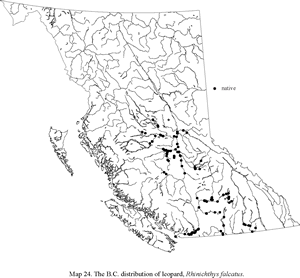This species has the snout free from the upper lip. Mouth horizontal, with well developed barbels at the corners of the jaw, narrow caudal peduncle (usually more than 3 times into head length); dorsal and anal fins are falcate; upper lobe of the daudal fin more pointed than in the longnose dace; usually 9 or 10 dorsal rays, 51-63 scales along the lateral line, dark irregular spots covering the back and sides. For further detailed information, refer to McPhail (2008).
Source: McPail, J. D. 2008. The Freshwater Fishes of British Columbia. University of Alberta Press, Edmonton.
